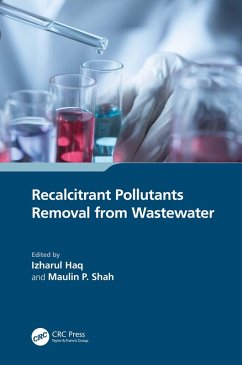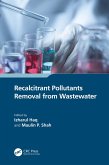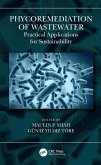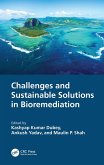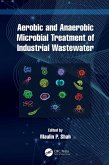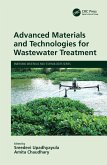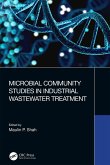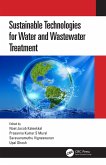Recalcitrant Pollutants Removal from Wastewater (eBook, PDF)
Redaktion: Haq, Izharul; Shah, Maulin P.
93,95 €
93,95 €
inkl. MwSt.
Sofort per Download lieferbar

47 °P sammeln
93,95 €
Als Download kaufen

93,95 €
inkl. MwSt.
Sofort per Download lieferbar

47 °P sammeln
Jetzt verschenken
Alle Infos zum eBook verschenken
93,95 €
inkl. MwSt.
Sofort per Download lieferbar
Alle Infos zum eBook verschenken

47 °P sammeln
Recalcitrant Pollutants Removal from Wastewater (eBook, PDF)
Redaktion: Haq, Izharul; Shah, Maulin P.
- Format: PDF
- Merkliste
- Auf die Merkliste
- Bewerten Bewerten
- Teilen
- Produkt teilen
- Produkterinnerung
- Produkterinnerung

Bitte loggen Sie sich zunächst in Ihr Kundenkonto ein oder registrieren Sie sich bei
bücher.de, um das eBook-Abo tolino select nutzen zu können.
Hier können Sie sich einloggen
Hier können Sie sich einloggen
Sie sind bereits eingeloggt. Klicken Sie auf 2. tolino select Abo, um fortzufahren.

Bitte loggen Sie sich zunächst in Ihr Kundenkonto ein oder registrieren Sie sich bei bücher.de, um das eBook-Abo tolino select nutzen zu können.
Recalcitrant Pollutants Removal from Wastewaters examines the role of indigenous microbes in the degradation and detoxification of wastewater utilizing the latest biological treatment technologies.
- Geräte: PC
- mit Kopierschutz
- eBook Hilfe
Andere Kunden interessierten sich auch für
![Recalcitrant Pollutants Removal from Wastewater (eBook, ePUB) Recalcitrant Pollutants Removal from Wastewater (eBook, ePUB)]() Recalcitrant Pollutants Removal from Wastewater (eBook, ePUB)93,95 €
Recalcitrant Pollutants Removal from Wastewater (eBook, ePUB)93,95 €![Phycoremediation of Wastewater (eBook, PDF) Phycoremediation of Wastewater (eBook, PDF)]() Phycoremediation of Wastewater (eBook, PDF)94,95 €
Phycoremediation of Wastewater (eBook, PDF)94,95 €![Challenges and Sustainable Solutions in Bioremediation (eBook, PDF) Challenges and Sustainable Solutions in Bioremediation (eBook, PDF)]() Challenges and Sustainable Solutions in Bioremediation (eBook, PDF)88,95 €
Challenges and Sustainable Solutions in Bioremediation (eBook, PDF)88,95 €![Aerobic and Anaerobic Microbial Treatment of Industrial Wastewater (eBook, PDF) Aerobic and Anaerobic Microbial Treatment of Industrial Wastewater (eBook, PDF)]() Aerobic and Anaerobic Microbial Treatment of Industrial Wastewater (eBook, PDF)97,95 €
Aerobic and Anaerobic Microbial Treatment of Industrial Wastewater (eBook, PDF)97,95 €![Advanced Materials and Technologies for Wastewater Treatment (eBook, PDF) Advanced Materials and Technologies for Wastewater Treatment (eBook, PDF)]() Advanced Materials and Technologies for Wastewater Treatment (eBook, PDF)50,95 €
Advanced Materials and Technologies for Wastewater Treatment (eBook, PDF)50,95 €![Microbial Community Studies in Industrial Wastewater Treatment (eBook, PDF) Microbial Community Studies in Industrial Wastewater Treatment (eBook, PDF)]() Microbial Community Studies in Industrial Wastewater Treatment (eBook, PDF)47,95 €
Microbial Community Studies in Industrial Wastewater Treatment (eBook, PDF)47,95 €![Sustainable Technologies for Water and Wastewater Treatment (eBook, PDF) Sustainable Technologies for Water and Wastewater Treatment (eBook, PDF)]() Sustainable Technologies for Water and Wastewater Treatment (eBook, PDF)69,95 €
Sustainable Technologies for Water and Wastewater Treatment (eBook, PDF)69,95 €-
-
-
Recalcitrant Pollutants Removal from Wastewaters examines the role of indigenous microbes in the degradation and detoxification of wastewater utilizing the latest biological treatment technologies.
Dieser Download kann aus rechtlichen Gründen nur mit Rechnungsadresse in A, B, BG, CY, CZ, D, DK, EW, E, FIN, F, GR, HR, H, IRL, I, LT, L, LR, M, NL, PL, P, R, S, SLO, SK ausgeliefert werden.
Produktdetails
- Produktdetails
- Verlag: Taylor & Francis
- Seitenzahl: 218
- Erscheinungstermin: 8. Oktober 2024
- Englisch
- ISBN-13: 9781040128251
- Artikelnr.: 72284253
- Verlag: Taylor & Francis
- Seitenzahl: 218
- Erscheinungstermin: 8. Oktober 2024
- Englisch
- ISBN-13: 9781040128251
- Artikelnr.: 72284253
- Herstellerkennzeichnung Die Herstellerinformationen sind derzeit nicht verfügbar.
Dr Izharul Haq is an Assistant Professor at Dr. B. Lal Institute of Biotechnology, Jaipur, India. He was previously employed as a Post-Doctoral Fellow in the Indian Institute of Technology Guwahati, India. He obtained his Ph.D. in Microbiology from CSIR-Indian Institute of Toxicology Research, Lucknow, India. He is working on liquid and solid waste management through microorganisms and their toxicity evaluation. He has 65 publications with h index of 18 and > 1600 citations. Dr Maulin P. Shah is currently working as a Deputy General Manager-Industrial Wastewater Research Lab, Division of Applied and Environmental Microbiology Lab at Enviro Technology Ltd., Ankleshwar, Gujarat, India. He received his Ph.D. (2002-2005) in Environmental Microbiology from Sardar Patel University, Vallabh Vidyanagar, Gujarat. He served as an Assistant Professor at Godhra, Gujarat University in 2001. He is a Microbial Biotechnologist with diverse research interests. A group of research scholars is working under his guidance on areas ranging from Applied Microbiology, Environmental Biotechnology, Bioremediation, and Industrial Liquid Waste Management to solid-state fermentation. His primary interest is the environment, the quality of our living resources, and the ways that bacteria can help to manage and degrade toxic waste and restore environmental health. Consequently, he is very interested in genetic adaptation processes in bacteria, the mechanisms by which they deal with toxic substances, how they react to pollution in general, and how we can apply microbial processes in a useful way (like bacterial bioreporters). One of our major interests is to study how bacteria evolve and adapt to use organic pollutants as novel growth substrates. Bacteria with new degradation capabilities are often selected in polluted environments and have accumulated small (mutations) and large genetic changes (transpositions, recombination, and horizontally transferred elements). His work has been focused on assessing the impact of industrial pollution on microbial diversity of wastewater following cultivation dependent and cultivation independent analysis. His major work involves isolation, screening, identification, and genetic engineering of high impact of microbes for the degradation of hazardous materials. He has more than 200 research publications in highly reputed national and international journals. He directs the Research Program at Enviro Technology Ltd., Ankleshwar. He has guided more than 100 postgraduate students in various disciplines of Life Science. He is an active editorial board member of more than 150 highly reputed journals in the environmental and biological sciences. He was Founder Editor-in-Chief of the International Journal of Environmental Bioremediation and Biodegradation (2012-2014) and Journal of Applied and Environmental Microbiology (2012-2014) (Science and Education Publishing, USA). He is actively engaged as an editorial board member of 32 Journals of high repute (Elsevier, Springer, Taylor & Francis, RSC, Wiley, KeAi, De Gruyter) He also serves as a reviewer of various journals of national and international repute. He has edited more than 200 books on wastewater microbiology, environmental microbiology, bioremediation, and hazardous waste treatment.
1. Bioengineering Approach Imbibed in Microorganisms toward Wastewater Treatment
2. Pharmaceuticals as Emerging Pollutants: An Insight on their Hazardous Impacts and Treatment Technologies
3. Toxic Metals Accumulation in Fungi for Wastewater Treatment Plant
4. Biological Sulfate Conversion: Role of Electron Donors
5. Bioremediation: A Prospective Tool for the Refurbishment of the Petroleum Contaminated Areas
6. Perspective on the Treatment of Brewery Wastewater Using Microalga
7. Environmental Pollution from Industrial Wastewater and its Bioremediation
8. Microbial Community in a Wastewater System: Proteobacteria and Cyanobacteria
9. Potentials of Microbes in Wastewater Treatment and Management
10. Microbes Assisted Development of Biofertilizer from Crop Stubble
2. Pharmaceuticals as Emerging Pollutants: An Insight on their Hazardous Impacts and Treatment Technologies
3. Toxic Metals Accumulation in Fungi for Wastewater Treatment Plant
4. Biological Sulfate Conversion: Role of Electron Donors
5. Bioremediation: A Prospective Tool for the Refurbishment of the Petroleum Contaminated Areas
6. Perspective on the Treatment of Brewery Wastewater Using Microalga
7. Environmental Pollution from Industrial Wastewater and its Bioremediation
8. Microbial Community in a Wastewater System: Proteobacteria and Cyanobacteria
9. Potentials of Microbes in Wastewater Treatment and Management
10. Microbes Assisted Development of Biofertilizer from Crop Stubble
1. Bioengineering Approach Imbibed in Microorganisms toward Wastewater Treatment
2. Pharmaceuticals as Emerging Pollutants: An Insight on their Hazardous Impacts and Treatment Technologies
3. Toxic Metals Accumulation in Fungi for Wastewater Treatment Plant
4. Biological Sulfate Conversion: Role of Electron Donors
5. Bioremediation: A Prospective Tool for the Refurbishment of the Petroleum Contaminated Areas
6. Perspective on the Treatment of Brewery Wastewater Using Microalga
7. Environmental Pollution from Industrial Wastewater and its Bioremediation
8. Microbial Community in a Wastewater System: Proteobacteria and Cyanobacteria
9. Potentials of Microbes in Wastewater Treatment and Management
10. Microbes Assisted Development of Biofertilizer from Crop Stubble
2. Pharmaceuticals as Emerging Pollutants: An Insight on their Hazardous Impacts and Treatment Technologies
3. Toxic Metals Accumulation in Fungi for Wastewater Treatment Plant
4. Biological Sulfate Conversion: Role of Electron Donors
5. Bioremediation: A Prospective Tool for the Refurbishment of the Petroleum Contaminated Areas
6. Perspective on the Treatment of Brewery Wastewater Using Microalga
7. Environmental Pollution from Industrial Wastewater and its Bioremediation
8. Microbial Community in a Wastewater System: Proteobacteria and Cyanobacteria
9. Potentials of Microbes in Wastewater Treatment and Management
10. Microbes Assisted Development of Biofertilizer from Crop Stubble
